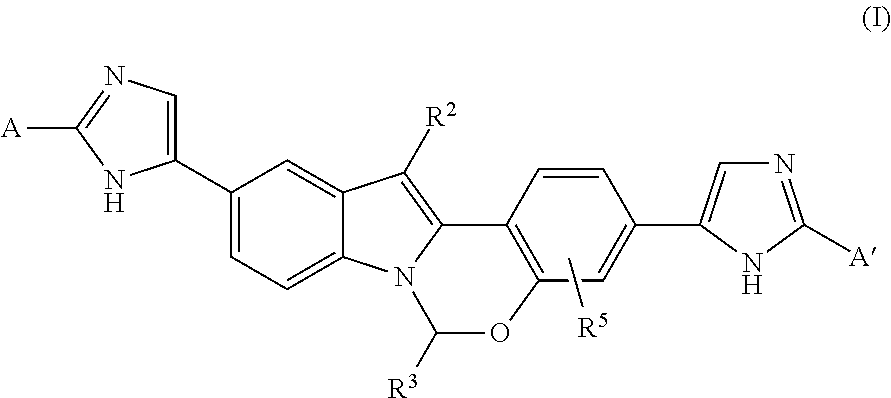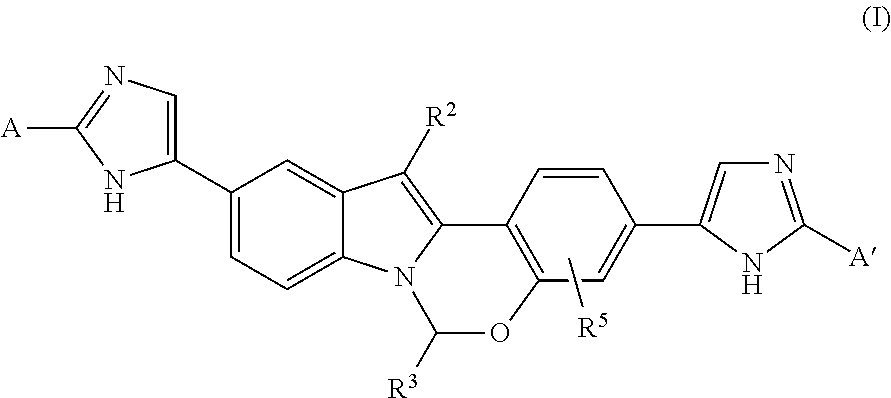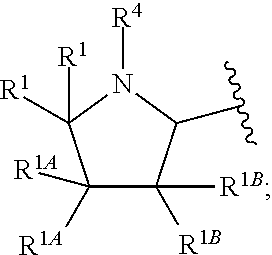Heterocycle-substituted tetracyclic compounds and methods of use thereof for the treatment of viral diseases
- Summary
- Abstract
- Description
- Claims
- Application Information
AI Technical Summary
Benefits of technology
Problems solved by technology
Method used
Image
Examples
example 1
Synthesis of Intermediate Compound 1D
[0155]
Step 1
[0156]To a solution of compound 1A (7.6 g, 70.7 mmol) and compound A (36.5 g, 283 mmol) in EtOH (100 mL) was added a solution of sodium (6.5 g, 283 mmol) in EtOH (150 mL) and the resulting suspension was allowed to stir at room temperature overnight. The reaction mixture was then added to water and extracted with ethyl acetate. The organic layer was dried over sodium sulfate, filtered and concentrated in vacuo, and the residue obtained was purified using flash column chromatography on silica gel to provide intermediate compound 1B. MS (ESI) m / z (M+H)+: 219.
Step 2
[0157]A solution of intermediate compound 1B (700 mg, 3.2 mmol) in toluene (20 mL) was allowed to stir for 4 hours at reflux. The reaction was concentrated in vacuo, and the residue obtained was purified using flash column chromatography on silica gel to provide intermediate compound 1C. MS (ESI) m / z (M+H)+: 191.
Step 3
[0158]To a solution of intermediate compound 1C (2.9 g, 15....
example 2
Synthesis of Intermediate Compound 2B
[0159]
[0160]To a solution of compound 2A (4.5 g, 54.2 mmol) in 60 mL of dry THF at −78 ° C. under a nitrogen atmosphere was added 1.1 equiv. of n-BuLi (2.5 M in THF) in THF and the reaction was allowed to stir for 45 minutes. DMF (3.96 g, 54.2 mmol) was added, and the reaction was allowed to stand overnight and warm to room temperature. The reaction mixture was then neutralized with 2N HCl and extracted with DCM (50 mL). The organic combined phases were combined, dried over Na2SO4, filtered, and concentrated in vacuo to provide intermediate compound 2B, which was used without further purification.
example 3
Synthesis of Intermediate Compound 3C
[0161]
Step 1
[0162]To a solution of N,O-dimethylhydroxyl amine hydrochloride (0.93 g, 9.67 mmol) in MeCN (50 mL) was added DIPEA (3.77 g, 29 mmol) dropwise, followed by compound 3A (1.5 g, 9.67 mol), then HATU (3.67 g, 9.67 mmol). The reaction was allowed to stir at room temperature for 30 minutes, then water was added, and the resulting solution was extracted with ethyl acetate. The organic layer was washed with brine, dried over Na2SO4, filtered and concentrated in vacuo. The residue obtained was purified using flash column chromatography on silica gel to provide compound 3B. 1H-NMR: (CDCl3, 400 MHz) δ: 6.72 (s, 1 H), 3.79 (s, 3 H), 3.33 (s, 3 H), 3.12-3.05 (m, 1 H), 1.28 (d, J=8 Hz, 6 H). MS (ESI) m / z (M+H)+: 199.
Step 2
[0163]A solution of compound 3B (1.7 g, 8.63 mmol) in dry THF was degassed and placed under N2 atmosphere, then was cooled to −75° C. DIBAL (1M in toluene, 9.5 mmol) was then added, and the reaction was allowed to stir for for 40...
PUM
| Property | Measurement | Unit |
|---|---|---|
| Therapeutic | aaaaa | aaaaa |
| Pharmaceutically acceptable | aaaaa | aaaaa |
Abstract
Description
Claims
Application Information
 Login to View More
Login to View More - R&D
- Intellectual Property
- Life Sciences
- Materials
- Tech Scout
- Unparalleled Data Quality
- Higher Quality Content
- 60% Fewer Hallucinations
Browse by: Latest US Patents, China's latest patents, Technical Efficacy Thesaurus, Application Domain, Technology Topic, Popular Technical Reports.
© 2025 PatSnap. All rights reserved.Legal|Privacy policy|Modern Slavery Act Transparency Statement|Sitemap|About US| Contact US: help@patsnap.com



